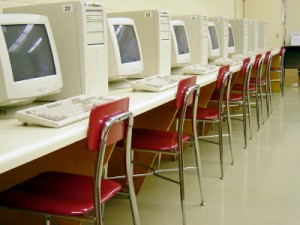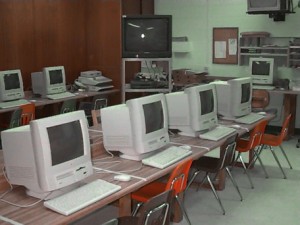A kinder gentler version of this article will be published in a forthcoming issue of The Creative Educator Magazine.
 Once upon a time, an enthusiastic creative teacher much like yourself used ye olde Visa card to buy a personal computer for her classroom. Back in ye days of Reagan, that teacher was excited by how the computer could be used by children to learn and make things never before imagined. The leaders of the village became so excited by what they saw in that pioneering classroom that they pooled their treasure to buy a dozen personal computers.
Once upon a time, an enthusiastic creative teacher much like yourself used ye olde Visa card to buy a personal computer for her classroom. Back in ye days of Reagan, that teacher was excited by how the computer could be used by children to learn and make things never before imagined. The leaders of the village became so excited by what they saw in that pioneering classroom that they pooled their treasure to buy a dozen personal computers.
The elders of the village wondered what to do with these new computers since there weren’t enough to put one in each classroom and few teachers shared the enthusiasm of the early adopter. Thus a decision was made to gather all of the school’s computers in a cave guarded by a computer teacher. A schedule would be carefully made to ensure that every student got to visit the cave at least once per season and the guard was given a curriculum for what to cover during those visits. As the number of computers increased the goals for what children did with them seemed be lowered. No longer did “computer literacy” mean that every child should have the expertise required to program the computer, but that they would be able to bookmark a web page or identify the mouse in a standardized “tech literacy” test. In 2010, schools have actually erected iPod labs so that students get to see such a new-fangled device, are taught to use it during iPod lessons and undoubtedly tested – resulting in some students failing iPod.
The moral of that tale is that the computer lab is a historical accident that need not be preserved in amber. If you happen to be your school’s computer teacher, you might consider the following pieces of advice for bringing greater benefit to students.

Ask yourself each day, “What if what kids did with computers was good?”
Don’t be surprised when kids do extraordinary things. Be surprised when adults are surprised. I expect that children can use computers in deeper more thoughtful ways than school traditionally asks of them. Cute may be a subset of “good,” but is a poor substitute.
Remember that quality work takes time
The average American student touches a computer for less than an hour per week at school. That’s obviously insufficient for any serious learning or creativity to result. Why not adjust the computer lab schedule to make it as open and flexible as a library? If students can come use a computer whenever they need to for as long as necessary, they’ll learn more, the computers will be used to greater benefit and the school will take an important step towards learner-centered school reform.
Shun ‘software du Jour’
Lots of teachers make the mistake of confusing quantity with quality. When you make kids jump from one software application to another you deprive them of any opportunity to develop fluency and reduce the odds they will learn or create something of substance. Afford kids the chance to become good at something. There are countless ways to draw a picture on the computer. You don’t need to teach every one of them.
Avoid false complexity
Memorizing menu options in Microsoft Office is a parlor trick that’s easily tested and has little to do with learning.
Stop using computer time for non-computing activities
Curricular concoctions like “keyboarding” are a waste of scarce computing resources and of questionable value. Digital citizenship and assessing information literacy should be part of the broader curriculum, taught by all, and doesn’t need to tie up your computers.
If a kid is breathing, she has probably surpassed the NETs
The ISTE NETs standards are unimaginative and technocentric. Declare that every child has satisfied them and move on.
Do the real thing
If you are thinking about teaching “digital storytelling,” try teaching writing or filmmaking. Those are serious disciplines with 100 to 1,000 years of tradition and wisdom behind them. Digital storytelling is something invented to fit within a class period. Burping into Voicethread is not storytelling. Kids are capable of engaging in serious filmmaking and writing, but only if we respect the artists who preceded us and commit to the entire writing process, regardless of the medium.
Aspire beyond mash-ups and remixes
If you look hard enough you may find a collage here and there in the world’s great art museums, but in most cases collage is the result of gluing magazine photos to construction paper. Mash-ups and remixes seem like new forms of collage to me. Of course you may reinterpret new ideas or stand on the shoulders of giants, but only en-route to the expression of a higher personal aesthetic.
Stop integrating someone else’s curriculum
It is not your job to invent dopey 37-minute Columbus Day computer activities. You’re enabling your colleagues to continue avoiding computers for a fourth decade. If kids develop computing competence and fluency with you, they will know how to integrate those skills into other subjects.
Not with my computers you don’t!
We are beginning to see movement towards using school computers for standardized testing and test-prep. This will reduce the quality and quantity of creative ways in which computers may be used to construct knowledge while giving a public the false sense of modernity and making school less relevant for children. It’s time to standup and say, “Not with my computers you don’t!”
Please subscribe to my newsletter
Photo credit:
Carey, Chris. ocps008.jpg. . Pics4Learning. 7 Dec 2010 <http://pics.tech4learning.com>
Veteran educator Gary Stager, Ph.D. is the author of Twenty Things to Do with a Computer – Forward 50, co-author of Invent To Learn — Making, Tinkering, and Engineering in the Classroom, publisher at Constructing Modern Knowledge Press, and the founder of the Constructing Modern Knowledge summer institute. He led professional development in the world’s first 1:1 laptop schools thirty years ago and designed one of the oldest online graduate school programs. Gary is also the curator of The Seymour Papert archives at DailyPapert.com. Learn more about Gary here.

Many years ago I was struck by something I read about how the computer lab was a defensive measure that kept all that scary technology in one box, away from the rest of the “real” teaching in a school. It made the computer teacher responsible for all things technological and freed classroom teachers from the technology threat. Parts of this unfortunate status quo remain in nearly every school today through both attitudes and facilities.
Gary,
Things are really bad here in Florida. My high school has designated one of our labs as “a test prep lab.” There is NOTHING creative going on in here EVER. It is used by English teachers to help prepare kids for the FCAT. In my opinion, these teachers are using it as more of a “time out of the classroom” event than anything else. In addition to this constant test prep, this year, the State of Florida has implemented online administration of the FCAT AND online “End of Course” testing for all of our freshmen (Algebra.) In order to accommodate this new online testing, the state provided us with nothing…not a single computer. Instead, we are forced to kick ALL of our business teachers (where MUCH creativity takes place) out of their classroom for 2 entire weeks at the end of the 2nd semester. It’s truly a travesty, but when our top level administration just lies down and takes it from the state, what can we teachers do?